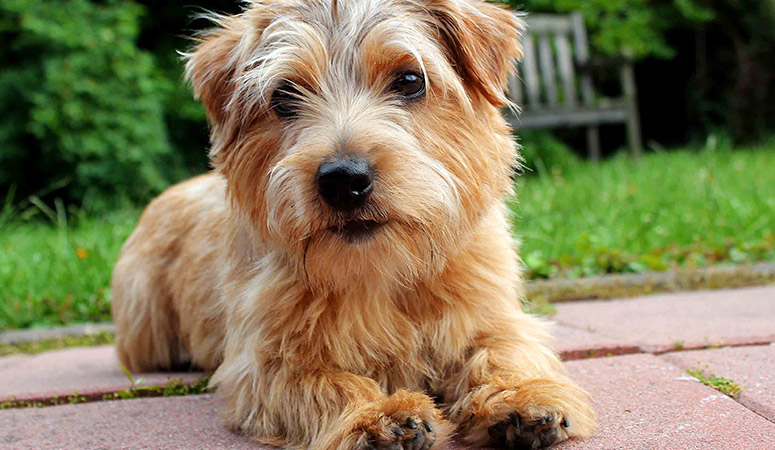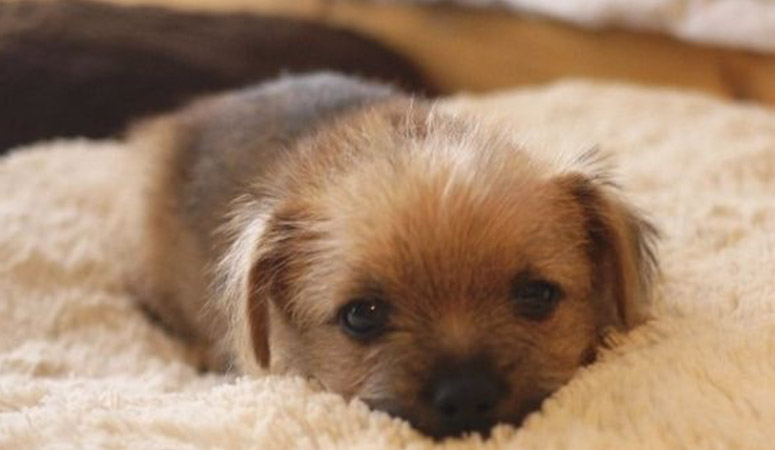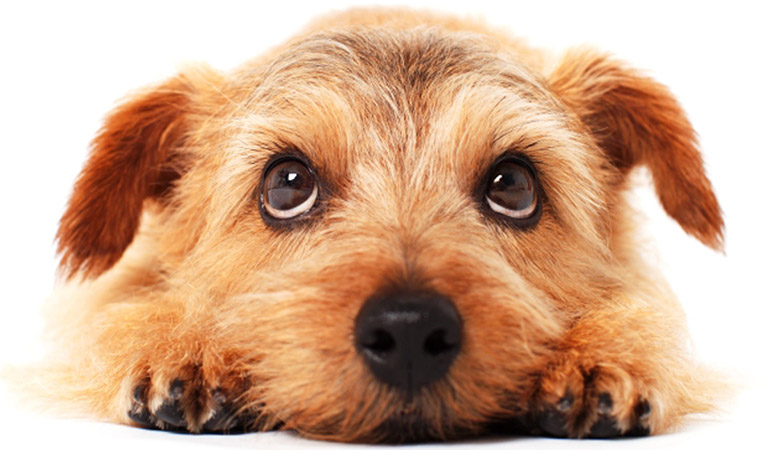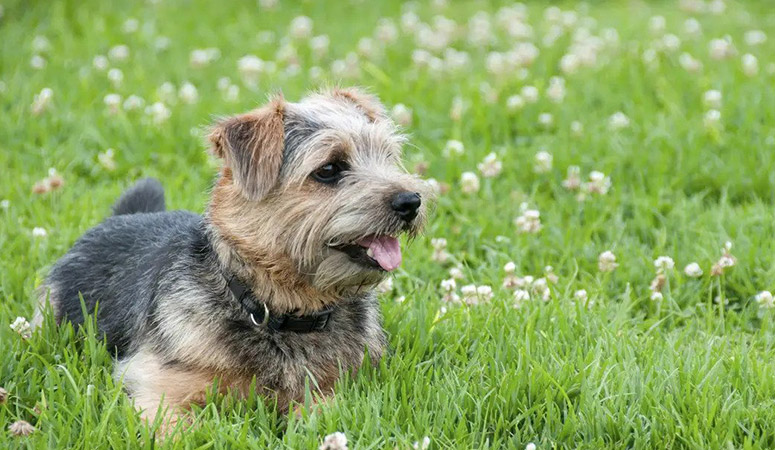Norfolk Terrier
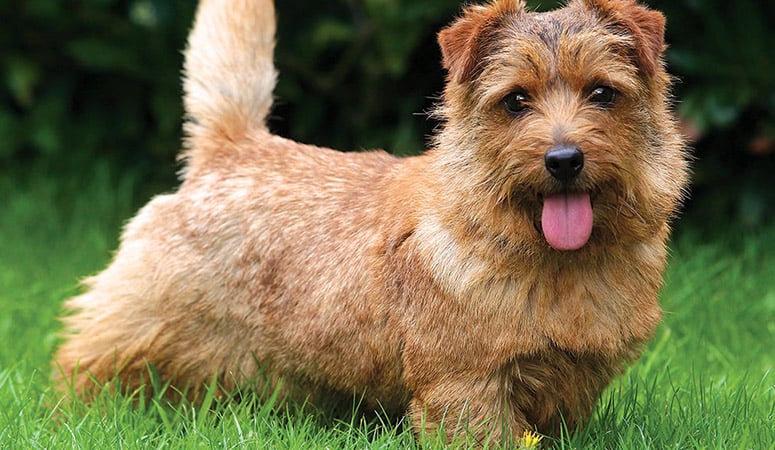
Rugged and cute, Norfolk Terriers are borderline toy dogs with big dog personalities. Despite their toyish qualities, this breed is a small alert dog who historically protected home and farm from rodents, working alone or in a pack, and they are loyal companions with the heart of a working terrier.
| Other Names | Norfolks |
| Color | Black & Tan, Grizzle, Red, Red Wheaten, Brown, Wheaten |
| Height | Males: 9-11 inches. Females: 8-11 inches. |
| Weight | Males: 11-12 pounds. Females: 10-11 pounds. |
| Life Span | 12-16 years |
| Personality | Fearless, Alert, Fun-Loving |
| Exercise | Regular Exercise |
| Origin |
| Popularity | #131 |
| Groom Needs | Weekly |
| Kids Friendly | Yes |
| Dog Friendly | Yes with supervision |
| Watch Dog | |
| Family Dog | |
| Litter Size | 1-3 |
Norfolk Terrier Pictures
Norfolk Terrier Video
Introduction
They are one of the smallest terriers to have originated from Britain. Norfolk Terriers, like their cousins (Norwich Terriers), are highly sociable animals that thrive better with human contact. They enjoy working in packs, are fearless, and may prove difficult at times. They come in a hard and wiry coat, which is weather-resistant. The coat color presents in different shades of wheaten, red, grizzle, or black and tan. They are small but compact, well-proportioned, and balanced. As adoptable dogs, they were originally bred as terriers with the perfect attributes for a remarkable one. However, nowadays, Norfolk Terriers make amiable companions and domestic dogs.
A standard size is likely to measure up to 9-11 inches at the shoulder, being small-sized dogs. Regardless the gender, a Norfolk Terrier should weigh no more than 11-13 pounds. They are confident and alert. On average, they live to around 11-16 years.
Living with Norfolk Terrier
The Norfolk Terrier has a wire coat that should be hand-tripped twice a year, a time-consuming process of pulling out loose hair with a tool called a stripping knife. You can do this yourself or take your dog to a professional groomer. Wire coats that are cared for properly by hand-stripping have a beautiful shine and rich color. In the meantime, the owner needs to brush or comb the coat every week.
Also, it is helpful to prevent gum disease with frequent tooth brushing with a soft toothbrush and doggie toothpaste. And check and clean your dog’s ears with a gentle and dog-friendly cleanser to prevent dirt buildup that may cause infections. Last, trim the nails every month to prevent painful cracking.
It is suggested to provide an hour-plus of physical activity and play every day for a healthy, adult Norfolk Terrier. They are energetic and thrive on active life, and a daily walk is a good option, also, they can jog for short distances. A shorter walk in the morning would be fine, but a longer more interesting one in the afternoon is a must with as much of the lead time as possible. The Norfolk should be on a leash while on outings or running free in a securely, fenced yard because of his active nature and extremely high prey drive.
Generally, it is recommended to feed the Norfolk Terrier with a half to one cup of high-quality dry dog food every day, divided into two meals. And there should be clean and fresh water at all times. More importantly, the food amount should depend on the dog’s weight, size, age, and activity level.
Some dogs are easy to get overweight, so you need to watch their calorie consumption and weight level all the time. Treats may be an important aid in training, but excessive intake can lead to obesity. Also, owners need to distinguish which human food is safe for dogs and which are not. If you have any problems with your dog’s weight or diet, just consult from your veterinarian.
Norfolk Terriers are prone to the following health conditions: patellar luxation, hip dysplasia, mitral valve disease, cataracts, lens luxation and glaucoma, possible vaccination sensitivity, etc.
Major concerns: CHD
Minor concerns: allergies
Occasionally seen: patellar luxation
Suggested tests:
Cardiac Exam
Patella Evaluation
Ophthalmologist Evaluation
Total Annual Cost: $2674
Cost is estimated for the first year and may vary depending on many factors, such as dog food, health care, leash, collar, licensing, possible fencing, crates, training and obedience classes, dog-walking, grooming, treats, toys, flea, tick, and heart-worm meds, microchips, etc.
This dog is intelligent and enjoys learning. But this dog may be challenging when training at times because of his natural independence and occasional stubbornness. It is suggested to use consistent and positive training to convince your dog to do what you ask. Also, you need to keep training sessions upbeat and interesting – repetition can bore them. If you are harsh with this breed, you’ll only get defensive behavior in return.
Besides, Norfolks can do well in advanced obedience and dog sports training, as long as training sessions are always kept upbeat and playful, and they are excellent candidates for Earthdog trials.
History
Norfolk and Norwich Terriers were regarded much as varieties of the same dog breed (under the name Norwich Terrier) all through history till 1964. The Norwich Terrier was recognized in two varieties, namely, the drop-eared type and the prick-eared type. The ancestor of this breed is believed to be a small terrier dog named “Rags”, which was bred by a Norwich breeder in the 1880s. Rags gave rise to litters and soon these progenies began to lay the foundation of modern Norwich Terriers. Descendants of this dog were later sold to an Irish breeder, Frank Jones, after which they were called the Jones Terriers around that time. Jones exported a couple of these dogs to the United States before World War I.
Until the 1930s, Norwich Terriers were bred in drop-eared and prick-eared varieties, and some breeders cropped the ears of the dogs until it was deemed illegal by the authorities. It was in the 1930s that intense efforts were made to distinguish the two varieties into distinct breeds. In 1932, the Norwich Terrier was officially recognized by the Kennel Club of England, and the first breed standard was written. However, the American Kennel Club registered the breed as the Norwich Terrier in 1936, a period when breed fanciers clamored for the separation of the drop-eared variety from the prick-eared. These mild agitations continued for some time, until 1964 when the Kennel Club separated them, classifying the drop-eared variety as the Norfolk Terrier, while the prick-eared variety retained the name Norwich Terrier.
The American Kennel Club (AKC) and the Canadian Kennel Club followed suit in 1979. The Norfolk Terrier was recognized by the United Kennel Club in 1979.
Helpful Information
Breed Club: NORFOLK TERRIER CLUB
Breed Club Link: http://www.norfolkterrierclub.org/
Breed Club Rescue:
Breed Club Rescue Link: http://norfolkterrierclub.org/rescue/

